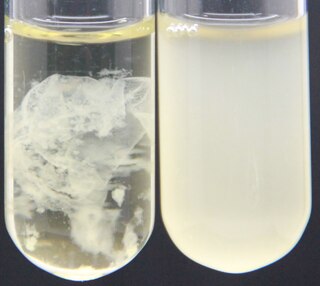Related Research Articles
The Thermotogota are a phylum of the domain Bacteria. The phylum Thermotogota is composed of Gram-negative staining, anaerobic, and mostly thermophilic and hyperthermophilic bacteria.

Escherichia is a genus of Gram-negative, non-spore-forming, facultatively anaerobic, rod-shaped bacteria from the family Enterobacteriaceae. In those species which are inhabitants of the gastrointestinal tracts of warm-blooded animals, Escherichia species provide a portion of the microbially derived vitamin K for their host. A number of the species of Escherichia are pathogenic. The genus is named after Theodor Escherich, the discoverer of Escherichia coli. Escherichia are facultative aerobes, with both aerobic and anaerobic growth, and an optimum temperature of 37 °C. Escherichia are usually motile by flagella, produce gas from fermentable carbohydrates, and do not decarboxylate lysine or hydrolyze arginine. Species include E. albertii, E. fergusonii, E. hermannii, E. ruysiae, E. marmotae and most notably, the model organism and clinically relevant E. coli. Formerly, Shimwellia blattae and Pseudescherichia vulneris were also classified in this genus.
Rubrobacter is a genus of Actinomycetota. It is radiotolerant and may rival Deinococcus radiodurans in this regard.
Methanococcus is a genus of coccoid methanogens of the family Methanococcaceae. They are all mesophiles, except the thermophilic M. thermolithotrophicus and the hyperthermophilic M. jannaschii. The latter was discovered at the base of a “white smoker” chimney at 21°N on the East Pacific Rise and it was the first archaeal genome to be completely sequenced, revealing many novel and eukaryote-like elements.
In taxonomy, Rhodothalassium is a genus of the Rhodobacteraceae. Up to now there is only one species of this genus known.
In taxonomy, Sulfitobacter is a genus of the Rhodobacteraceae.
Natrinema is a genus of the Natrialbaceae.
Actinokineospora is a genus in the phylum Actinomycetota (Bacteria).

Zoogloea, also known as zoöglœa, is a genus of gram-negative, aerobic, rod-shaped bacteria from the family of Zoogloeaceae in the Rhodocyclales of the class Betaproteobacteria.
Pseudoxanthomonas is a genus of Gram-negative bacteria in the family Xanthomonadaceae from the phylum Pseudomonadota. This genus is closely related phylogenetically with the genera Xanthomonas, Xylella, and Stenotrophomonas. The genus was first distinguished in 2000 in biofilter samples, and was later emended by Lee et al. Some of the species in this genus are: P. mexicana, P. japonensis, P. koreensis, P. daejeonensis, and the type species P. broegbernensis.
Aquamicrobium ahrensii is a gram-negative, aerobic, bacteria from the genus of Aquamicrobium which was isolated from biofilter from an animal rendering plant in Germany.
Aquamicrobium defluvii is a gram-negative, oxidase- and catalase-positive, bacteria from the genus of Aquamicrobium which was isolated from activated sewage sludge in Germany. Oxygen can be used as a terminal electron accpetor. Different carbons were tested but only a few sugars, fatty acids and thiophene 2-carboxylate supported growth The genomic information about these species is limited and more research is needed. . Aquamicrobium defluvii uses thiophene-2-carboxylate as only source for carbon.
Aquamicrobium lusatiense is a Gram-negative, oxidase-positive, strictly aerobic bacteria from the genus Aquamicrobium with a polar flagellum, which was isolated from activated sludge in Germany. Aquamicrobium lusatiense is able to degrade 2,4-dichlorophenol, 4-chloro-2-methylphenol, 4-chlorophenol, and phenol.
Aquamicrobium segne is a Gram-negative, aerobic bacteria from the genus Aquamicrobium which was isolated from a biofilter of an animal rendering plant in Germany.
Virgibacillus is a genus of Gram-positive, rod-shaped (bacillus) bacteria and a member of the phylum Bacillota. Virgibacillus species can be obligate aerobes, or facultative anaerobes and catalase enzyme positive. Under stressful environmental conditions, the bacteria can produce oval or ellipsoidal endospores in terminal, or sometimes subterminal, swollen sporangia. The genus was recently reclassified from the genus Bacillus in 1998 following an analysis of the species V. pantothenticus. Subsequently, a number of new species have been discovered or reclassified as Virgibacillus species.
Chloroflexales is an order of bacteria in the class Chloroflexia. The clade is also known as filamentous anoxygenic phototrophic bacteria (FAP), as the order contains phototrophs that do not produce oxygen. These bacteria are facultative aerobic. They generally use chemotrophy when oxygen is present and switch to light-derived energy when otherwise. Most species are heterotrophs, but a few are capable of photoautotrophy.
Chryseobacterium marinum is a bacterium from the genus Chryseobacterium.
Ottowia is a genus of bacteria from the family of Comamonadaceae.
Thermoleophilum is a genus of Actinomycetota.
Lysinibacillus is a genus of bacteria from the family of Bacillaceae. Members of this genus, in contrast to the type species of the genus Bacillus, contains peptidoglycan with lysine, aspartic acid, alanine and glutamic acid.
References
- ↑ LPSN lpsn.dsmz.de
- ↑ "Straininfo of Aquamicrobium aerolatum". Archived from the original on 2014-05-06. Retrieved 2014-03-16.
- 1 2 UniProt
- 1 2 Kampfer, P.; Martin, E.; Lodders, N.; Jackel, U. (2009). "Transfer of Defluvibacter lusatiensis to the genus Aquamicrobium as Aquamicrobium lusatiense comb. Nov. And description of Aquamicrobium aerolatum sp. nov". International Journal of Systematic and Evolutionary Microbiology. 59 (10): 2468–70. doi: 10.1099/ijs.0.008730-0 . PMID 19622662.
- ↑ Deutsche Sammlung von Mikroorganismen und Zellkulturen